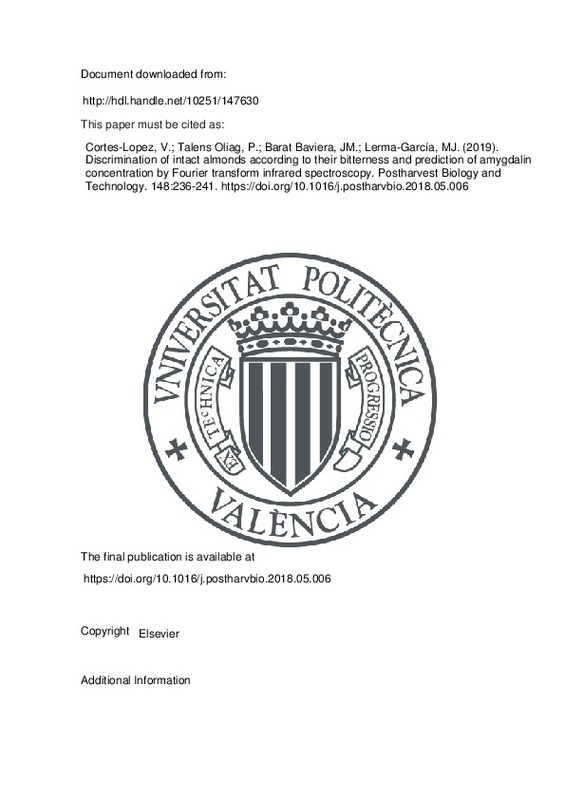JavaScript is disabled for your browser. Some features of this site may not work without it.
Buscar en RiuNet
Listar
Mi cuenta
Estadísticas
Ayuda RiuNet
Admin. UPV
Discrimination of intact almonds according to their bitterness and prediction of amygdalin concentration by Fourier transform infrared spectroscopy
Mostrar el registro sencillo del ítem
Ficheros en el ítem
| dc.contributor.author | Cortes-Lopez, Victoria
|
es_ES |
| dc.contributor.author | Talens Oliag, Pau
|
es_ES |
| dc.contributor.author | Barat Baviera, José Manuel
|
es_ES |
| dc.contributor.author | Lerma-García, María Jesús
|
es_ES |
| dc.date.accessioned | 2020-07-08T03:32:21Z | |
| dc.date.available | 2020-07-08T03:32:21Z | |
| dc.date.issued | 2019-02 | es_ES |
| dc.identifier.issn | 0925-5214 | es_ES |
| dc.identifier.uri | http://hdl.handle.net/10251/147630 | |
| dc.description.abstract | [EN] Intact almond kernels (N¿=¿360, half sweet and half bitter) were analyzed using attenuated total reflectance Fourier transform infrared spectroscopy (ATR-FTIR) for the prediction of amygdalin concentration and to classify them according to their bitterness. Amygdalin concentrations for sweet and bitter almonds, determined by high performance liquid chromatography, were between 0.7¿350 and 15,000-50,000¿mg kg¿1, respectively. Concentrations were successfully predicted by applying partial least squares (PLS) to the pre-treated spectral data with R2p of 0.951 and RMSEP of 0.398. Additionally, linear discriminant analysis (LDA), quadratic discriminant analysis (QDA) and PLS-DA models were constructed to classify samples according to their bitterness. All three models provided a satisfactory discrimination of almonds into sweet and bitter categories, providing overall accuracy values of 83.3%, 86.1% and 98.6%, respectively. The results indicate the potential of ATR-FTIR spectroscopy for the reliable, easy and fast prediction of amygdalin concentration, and for almond classification according to their bitterness. | es_ES |
| dc.description.sponsorship | Victoria Cortés López thanks the Spanish Ministry of Education, Culture and Sports for the FPU grant (FPU13/04202). The authors wish to thank the cooperative Agricoop for kindly donating the almonds. | es_ES |
| dc.language | Inglés | es_ES |
| dc.publisher | Elsevier | es_ES |
| dc.relation.ispartof | Postharvest Biology and Technology | es_ES |
| dc.rights | Reserva de todos los derechos | es_ES |
| dc.subject | ATR-FTIR | es_ES |
| dc.subject | Amygdalin concentration | es_ES |
| dc.subject | Bitterness | es_ES |
| dc.subject | Intact almonds | es_ES |
| dc.subject | PLS | es_ES |
| dc.subject | Almond discrimination | es_ES |
| dc.subject.classification | TECNOLOGIA DE ALIMENTOS | es_ES |
| dc.title | Discrimination of intact almonds according to their bitterness and prediction of amygdalin concentration by Fourier transform infrared spectroscopy | es_ES |
| dc.type | Artículo | es_ES |
| dc.identifier.doi | 10.1016/j.postharvbio.2018.05.006 | es_ES |
| dc.relation.projectID | info:eu-repo/grantAgreement/MECD//FPU13%2F04202/ES/FPU13%2F04202/ | es_ES |
| dc.rights.accessRights | Abierto | es_ES |
| dc.contributor.affiliation | Universitat Politècnica de València. Departamento de Tecnología de Alimentos - Departament de Tecnologia d'Aliments | es_ES |
| dc.description.bibliographicCitation | Cortes-Lopez, V.; Talens Oliag, P.; Barat Baviera, JM.; Lerma-García, MJ. (2019). Discrimination of intact almonds according to their bitterness and prediction of amygdalin concentration by Fourier transform infrared spectroscopy. Postharvest Biology and Technology. 148:236-241. https://doi.org/10.1016/j.postharvbio.2018.05.006 | es_ES |
| dc.description.accrualMethod | S | es_ES |
| dc.relation.publisherversion | https://doi.org/10.1016/j.postharvbio.2018.05.006 | es_ES |
| dc.description.upvformatpinicio | 236 | es_ES |
| dc.description.upvformatpfin | 241 | es_ES |
| dc.type.version | info:eu-repo/semantics/publishedVersion | es_ES |
| dc.description.volume | 148 | es_ES |
| dc.relation.pasarela | S\383877 | es_ES |
| dc.contributor.funder | Ministerio de Educación, Cultura y Deporte | es_ES |







![[Cerrado]](/themes/UPV/images/candado.png)

